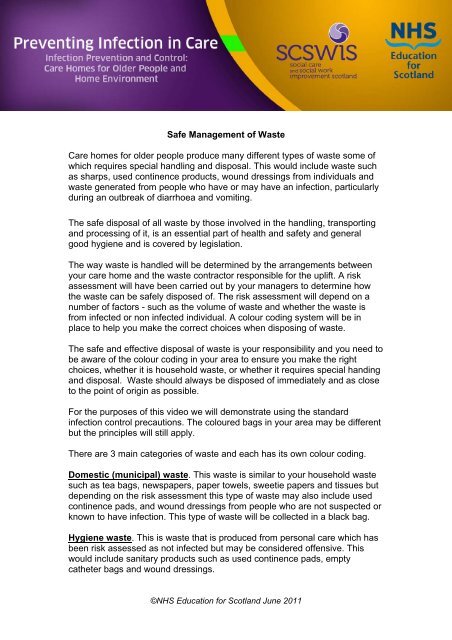Safe Management of Waste
Safe Management of Waste
Safe Management of Waste
Create successful ePaper yourself
Turn your PDF publications into a flip-book with our unique Google optimized e-Paper software.
<strong>Safe</strong> <strong>Management</strong> <strong>of</strong> <strong>Waste</strong>Care homes for older people produce many different types <strong>of</strong> waste some <strong>of</strong>which requires special handling and disposal. This would include waste suchas sharps, used continence products, wound dressings from individuals andwaste generated from people who have or may have an infection, particularlyduring an outbreak <strong>of</strong> diarrhoea and vomiting.The safe disposal <strong>of</strong> all waste by those involved in the handling, transportingand processing <strong>of</strong> it, is an essential part <strong>of</strong> health and safety and generalgood hygiene and is covered by legislation.The way waste is handled will be determined by the arrangements betweenyour care home and the waste contractor responsible for the uplift. A riskassessment will have been carried out by your managers to determine howthe waste can be safely disposed <strong>of</strong>. The risk assessment will depend on anumber <strong>of</strong> factors - such as the volume <strong>of</strong> waste and whether the waste isfrom infected or non infected individual. A colour coding system will be inplace to help you make the correct choices when disposing <strong>of</strong> waste.The safe and effective disposal <strong>of</strong> waste is your responsibility and you need tobe aware <strong>of</strong> the colour coding in your area to ensure you make the rightchoices, whether it is household waste, or whether it requires special handingand disposal. <strong>Waste</strong> should always be disposed <strong>of</strong> immediately and as closeto the point <strong>of</strong> origin as possible.For the purposes <strong>of</strong> this video we will demonstrate using the standardinfection control precautions. The coloured bags in your area may be differentbut the principles will still apply.There are 3 main categories <strong>of</strong> waste and each has its own colour coding.Domestic (municipal) waste. This waste is similar to your household wastesuch as tea bags, newspapers, paper towels, sweetie papers and tissues butdepending on the risk assessment this type <strong>of</strong> waste may also include usedcontinence pads, and wound dressings from people who are not suspected orknown to have infection. This type <strong>of</strong> waste will be collected in a black bag.Hygiene waste. This is waste that is produced from personal care which hasbeen risk assessed as not infected but may be considered <strong>of</strong>fensive. Thiswould include sanitary products such as used continence pads, emptycatheter bags and wound dressings.©NHS Education for Scotland June 2011
These items may be placed in a yellow bag with a black stripe <strong>of</strong>ten referredto as tiger bags or, depending on the local agreement between your carehome and the waste contractor, a black bag may be appropriate.Hazardous (special) waste <strong>of</strong>ten referred to as clinical or infectious waste.This waste consists <strong>of</strong> items that are contaminated or likely to becontaminated with infected blood and body fluids for example during anoutbreak <strong>of</strong> infection. An orange bag or yellow bag is used for this type <strong>of</strong>waste.Special arrangements are required for people receiving medication ortreatment with chemotherapy or low level radioactive tests. Check with yourlocal policy what colour bag or container is used for this type <strong>of</strong> waste.For all hazardous (special) waste extra care needs to be taken - you shouldalways wear apron and gloves and may need to wear face protection if thereis a risk <strong>of</strong> splashes or spills.<strong>Waste</strong> bags must be strong enough to avoid ripping or avoidable spillage andmust be no more than ¾ full when tied and transported to the storage areaawaiting collection.<strong>Waste</strong> produced as a direct result <strong>of</strong> healthcare activities such as technicalprocedures or injections must be risk assessed. Sharps containers would betreated as hazardous (special) waste and have an appropriate uplift by acontractor.These containers must be sealed and labelled and placed in a safe securearea until collected by the waste contractor. They must not be placed insideanother waste bag.No matter what waste you have been handling and regardless <strong>of</strong> whether youwere wearing gloves, hands must be washed immediately afterwards.To break the chain <strong>of</strong> infection:Remember: Different types <strong>of</strong> waste must be treated differently Understand correct colour code system for waste disposal in yoursetting Wear PPE when dealing with soiled waste Never overfill bags Always wash your hands immediately after handling waste <strong>of</strong> any kind©NHS Education for Scotland June 2011
















